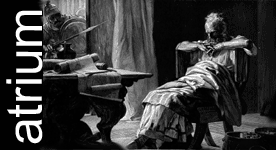From the Chicago Tribune:
Sometimes a guy just has to ungird his inner gladiator.
Sergio Iacomoni used to look up from his desk at Banca d'Italia and wonder about the likes of Spartacus. The father of two consumed books on ancient Rome. He tracked news of archeological digs, daily fare in Italy, for nuggets on how gladiators might have trained or lived. He socialized with buddies—accountants and bureaucrats cooped up in their own office or government jobs—who shared the same kind of Walter Mitty daydreams.
"One day, we were talking. We had played enough tennis, worked out with enough sports. So we decided: OK, now we'll be gladiators," Iacomoni said.
The men, whose graying temples hadn't dimmed memories of boyhood soldiering, began spending hours thinking up games and exercises that they imagined ancient warriors would use.
Iacomoni went further: He began calling himself Nerone and wondering whether this lifestyle could fit into a modern Rome budget.
The middle-age dad began pounding out metal helmets, twisting leather straps into sandals and designing the kind of garb that Charlton Heston, in his "Ben-Hur" days, might have appreciated. He then floated a petition to scout for other people who might want to join a club, a foundation of sorts, to preserve some Roman heritage.
Gruppo Storico Romano, as he called it, quickly pulled in dozens of members. More than a decade later, about a hundred Romans are loyal to the cause. Iacomoni qua Nerone said the initial response led him to explore a business opportunity.
In 2004 he opened a school for modern-day gladiators, a small, shady rural outpost off the Via Appia Antica, the ancient Roman road. It is part learning center, part tourist attraction and even provides a lovely spectator sport for those not inclined to swing a sword on a warm spring day.
Trident in hand
These days, the 56-year-old said with a laugh, are spent doing what every Roman boy dreams. He dons leather sandals and a deep-red tunic and spends hours heaving wooden swords and metal tridents up and down the dusty little arena he has created for the gladiator-wannabes. He works every day in the sunshine. His friends come by after work, all still eager to play gladiator.
"This is our passion," said 60-year-old Michele Forglione, a logistician at Italy's Defense Ministry.
Any day of the week, Nerone has schoolchildren from around Rome learning the fine art of slaying their imaginary dragons or foes. "Head and back, neck and back," he calls out, teaching the youngsters to swing and step back, deftly challenging their opponents' body parts and protecting their own. If it seems like shtick in the first minutes, children quickly learn that there is a purpose to the play.
Nerone keeps youngsters—and adult tourists or families who enlist in far more challenging exercises—on their toes. The 1st Century warriors were men to be remembered, he believes, and his courses take Roman history seriously. He also runs a small museum in the back of his lot. He admits that not a lot is known about the actual life of a gladiator, so Nerone spends his time—and his buddies'—contemplating how to hone Roman physical glory.
"The history of Rome is all along the ruins," he said. "But for gladiators, a lot has to be interpreted. The fact is that there is not a lot of documentation. ... So we've tried to understand what was real and what was known. If an archeologist finds something or tells us something was not really used, we no longer do it.
"You have to build something authentic. If you build something strong from the beginning, there will always be a strong base to build on."
Net flicks (and DVDs too)
Instructors teach with fishnets at first, swinging them, side to side and overhead, to encourage coordination. Students joust with 5-pound helmets on their heads to understand the weight, emotional and otherwise, of battle. Nerone, during breaks in the three-hour classes, also taps into a computer and flips through DVDs to bring Rome's ancient treasures into this century.
He markets his specialty well: The group has been featured on the Discovery Channel. His school, one of several in Rome, is booked with private groups and educational sessions throughout the year.
And every April his merry band of self-made historians takes over the streets of Rome—tromping from the Forum to Colosseum to the Circus Maximus—for an eye-popping celebration. They parade in costume to mark "Natale di Roma," the anniversary of Rome's founding, according to legend. This year, Rome was teeming one Sunday with short-skirted men roaming the cobblestones with authority.
"I think lots of people come here and want to feel Roman," Nerone said as he prepared for another class. "Some people have it in their blood. Foreigners come and envy the history."
